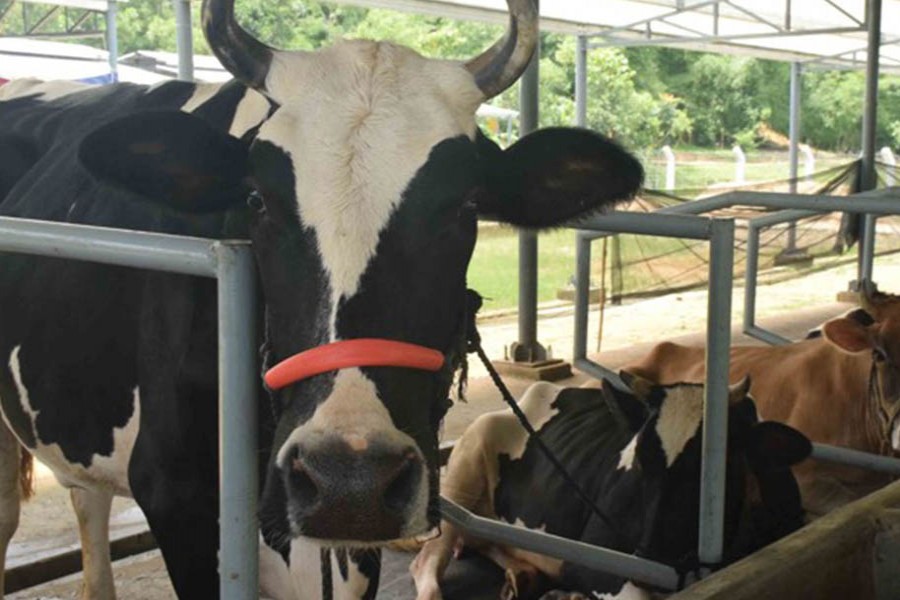Deliberations on dairy farm at a roundtable arranged by a Bangla contemporary in the city on Tuesday last have centred around the various problems facing dairy farmers. Of the 81,000 dairy farms, more than 50,000 have been set up by entrepreneurs with a bachelor degree. This should have started a quiet revolution on the milk front. But unfortunately it has not happened.
What has escaped notice is that production of milk has gone up courtesy of such farms under supervision of an educated breed of dairy farmers but theirs is an isolated initiative each. Their main focus is on production, not on marketing. The farmers have to depend on packaging companies which collect milk from them from designated spots. It is the packaging companies which dictate terms.
If milk production is constrained by isolated individual farms, promotion of milk and marketing of this nourishing food along with other dairy products have not been their own preserve. Moreover, production cost has been too high to help expand the dairy industry in the country. Highly nutritious, milk should have been a regular drink. Instead, carbonated drinks seem to have taken the market by storm. The young generation is the target of a virulent campaign by different multinational companies. Pitted against those beverages, milk cuts a sorry figure, indeed!
It would be wrong to blame the older generation for not highlighting the many benefits of milk. Members of that generation were well aware of milk's virtue but supply of milk was limited. Today, there is a concerted attempt to take the focus out of milk. Western people, on the other hand, prize milk highly because they know what may be the consequences of calcium deficiency in human body. Elderly people, women in particular, may suffer osteoporosis -a disease of bones.
Of late the educated class here is becoming aware of the threat posed by calcium deficiency. Yet people are yet to include milk as a regular drink to their diet. The discussants are right to identify a lack of campaign for milk intake. Compared to the promotion of egg -another easily available nutritious food, milk has received little national attention.
Can milk take its rightful place in the development of the nation's health? Perhaps, the arguments in favour of government subsidy and training on animal husbandry for farmers are actually missing the wood for the trees. Isolated initiatives for dairy development without a national goal or vision cannot proceed much further.
In this connection, Verghese Kurien, known as the Father of the White Revolution in India may throw some light on taking ahead the task of dairy development in Bangladesh. A social entrepreneur, Verghese was instrumental in developing the world's largest dairy industry in India. It is also the largest self-sustaining industry in India -one that has to its credit the distinction of providing the largest rural employment there. By a sudden pull, the visionary entrepreneur took India to the pole position of the world's milk producing countries from a milk-deficient nation.
The man of steely resolve pioneered the 'Anand Pattern' of dairy cooperatives and replicated it all across India. To make his Amul the largest food brand in India, he, however, had to fight many odds. A crucial invention at Amul, the world's first, was the production of milk powder from buffalo milk which was and is abundant in that country.
The Milk Vita was initially built up on an arrangement like this but it soon lost its way in the wilderness in the absence of efficient management and visionary leadership. Milk is a commodity that must go through some well orchestrated supply chain in order to reach its consumers. Without modern technology and machines for chilling and transportation, it cannot retain its quality and be used for manufacture of other dairy products.
Farmers are the last person to procure such technologically advanced facilities. The private companies are unlikely to give farmers the benefits Verghese's cooperatives introduced from the day one. Here the Milk Vita has exposed its weaknesses and made screaming news for loss making. Perhaps an Amul-type system can be an answer to the country's problem with dairy development. Now that educated youths have been at the helm of dairy affairs at the grass-roots level, the need is to bring them under a system like that of Verghese. It will ensure the lion's share of benefit for dairy farmers and factories or the industry will also enjoy their reasonable share.
What has been the driving engine of Amul should be studied from close quarters and, if found suitable, may be replicated here for development of a dairy industry. Production cost of milk can be brought down if all concerned go for improved technology for feed production and management of farm.
Last but not least, the quality of packaged milk has long been a subject of speculation. Samples were collected for determination of qualities of different brands a few months before but the results are yet to be made public. Why is there such an inordinate delay? The authorities should expedite the process no matter if the results are unpalatable. Even here is a subject that warrants streamlining the country's dairy industry.


